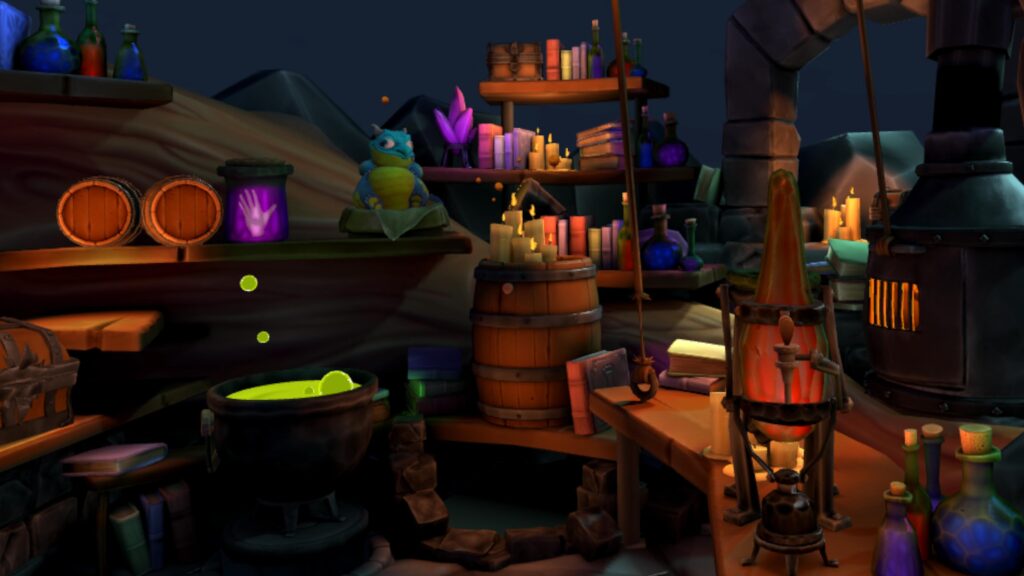Interpretive Communication with Elixir for Quest 2
 Edwige Simon, Ph.D., Online Learning and Instructional Technology Director at the International Center for Language Studies, Washington DC.
Edwige Simon, Ph.D., Online Learning and Instructional Technology Director at the International Center for Language Studies, Washington DC.
DOI: https://www.doi.org/10.69732/ZBAX1081
| Name of tool | Elixir for Oculus Quest 2 |
| URL | http://elixir.magnopus.com/ |
| Primary purpose | VR experience for interpretive listening |
| Cost | The Elixir experience is free, but the Oculus headset is $300 |
| Ease of use | 4/5 Users reported some glitches, but I have not experienced any myself |
Summary
Elixir for Quest 2 is a VR experience available for free on the Oculus Quest 2 headset, where you play the part of an apprentice applying for an internship with a sorceress. Elixir was designed by Magnopus, a company that creates immersive VR experiences.
The experience begins with a hand and finger tracking tutorial led by a pair of hands (see picture below). The tutorial allows you to become comfortable teleporting around the laboratory.

Over the course of the 15- to-20-minute experience, you follow the verbal instructions of an invisible sorceress who tells you what to do and what not to do, with unexpected and mesmerizing results at times. For example, you get to poke a dragon’s belly, chase runaway eyeballs, and immerse your virtual hands in a cauldron only to find them transformed (spoiler alert) into tentacles or monstrous claws.

The experience is engaging and immersive, and the graphics crisp and colorful. Using hand and finger tracking instead of the controllers adds a sense of “being there.”

Elixir is available in English, French, German, Italian, Japanese, and Spanish. It presents an excellent opportunity for intermediate-mid (and up) learners to engage in interpretive listening as they’ll need to understand the instructions given by the sorceress to complete the experience.
Although the game does not allow for user-to-user interaction, it presents many opportunities for wrap-around activities before and after engaging with the experience.
Wrap-around Activities
Before activities
- Students will need help learning relevant vocabulary before debriefing their experience. You can download screenshots from the press kit or take screenshots in the game to introduce vocabulary such as cauldron, magnetic field, or dragon vomit.
- Discuss famous witches or wizards from literature, movies, or video games, and discuss physical and personality attributes and clichés.
- Discuss the qualities a sorceress’s apprentice must have to be successful, write a job description and describe the type of practical tests an apprentice would need to pass to get hired.
- Do a mock interview with a sorcerer/sorceress.
During the experience
- Have students go through the experience, taking screenshots or screencasts of their favorite parts and incorporate these elements in your follow-up lesson. Note that you can also stream a student’s experience live on a TV or computer screen for others to follow along.
After activities
- Using screenshots from the experience, have students recreate the experience by putting the screenshots in chronological order.
- Ask students to debrief their experience and show their favorite parts (using the screenshots and/or screencast).
- Have students write a follow-up scenario for their first day on the job.
Integration in the curriculum
The topic itself may be a bit difficult to incorporate into the intermediate (or advanced) classroom as most curricula do not typically include a unit on magic spells or sorcery. However, this activity could be implemented as part of a game night in a language center. With proper scaffolding, Elixir could also become integrated into a unit on the imperative form.
Using the Oculus headset
This article assumes you have access to enough Oculus Quest 2 headsets for all your students to go through the experience, which lasts about 20 minutes. At $300 per headset, it is a costly activity. However, consider reaching out to various campus organizations to find out who may have headsets and whether they would consider loaning them to your class and have students take turns completing the experience. Another option would be to have students make an appointment to complete the experience at the language center and then complete the wrap-around activities in class.
If this is the first time your students use a VR headset, they will need some time to get used to it. That said, my 10-year-old daughter went through the entire experience with no instructions and without any issues. Regardless of students’ prior experience with VR headsets, I recommend limiting students’ time in VR to under 30 minutes.
Elixir is a fun experience that students are sure to enjoy. One can easily imagine substituting the fantasy setting for more authentic situations where language learners must follow verbal instructions to complete a task (follow a recipe, repair an object, put items in a certain order, etc.). It will be interesting to see what other experiences become available from the Meta app store in the future.

